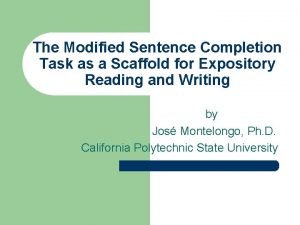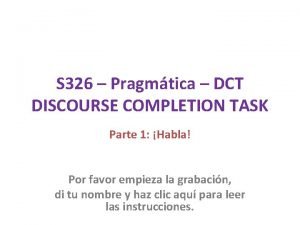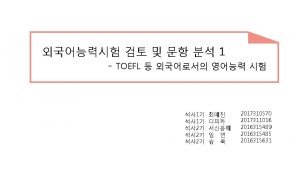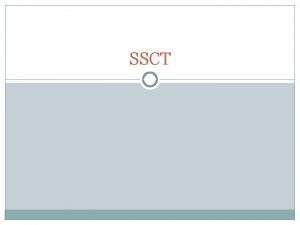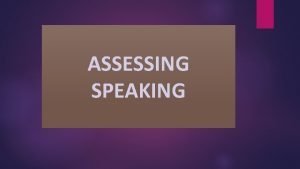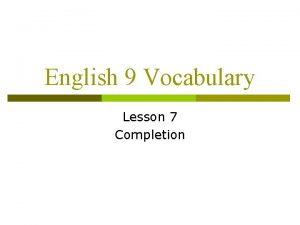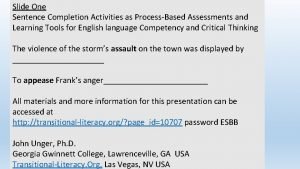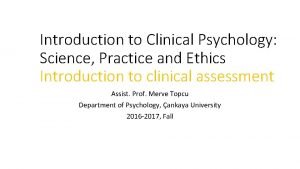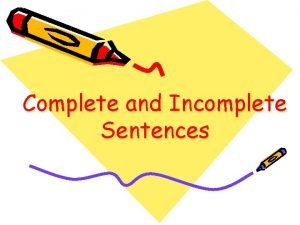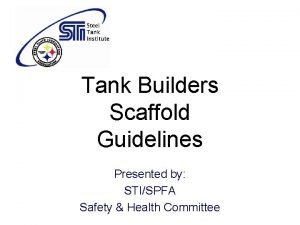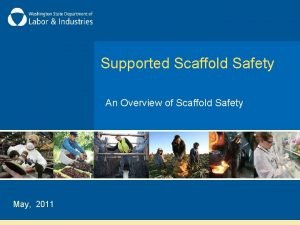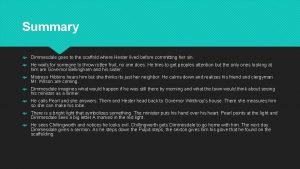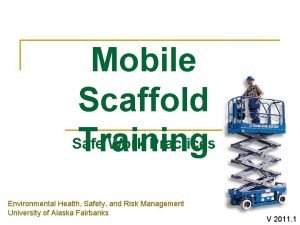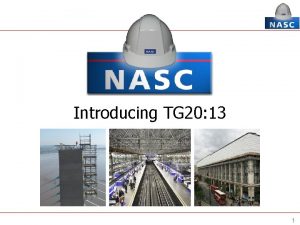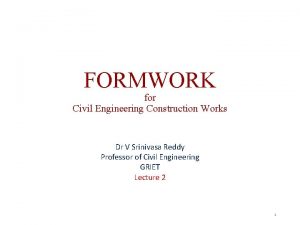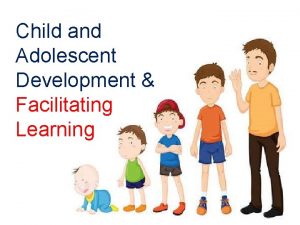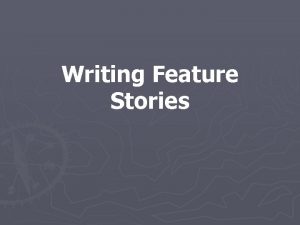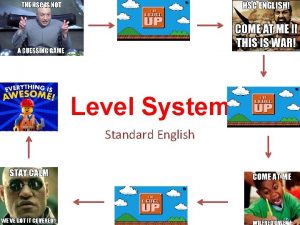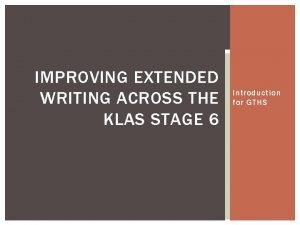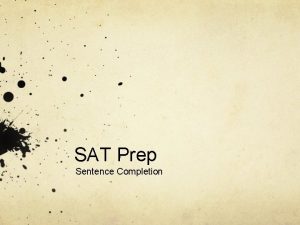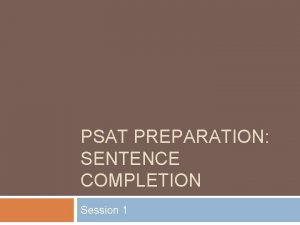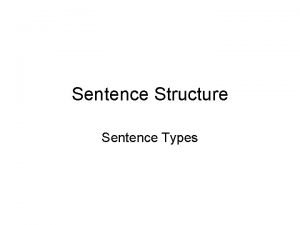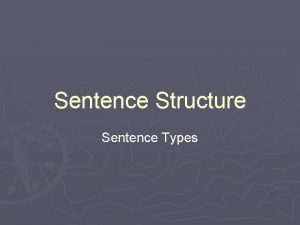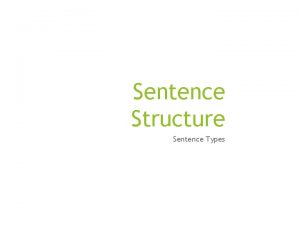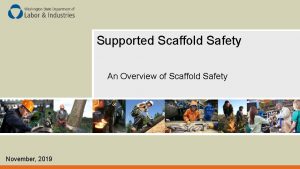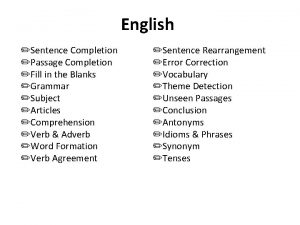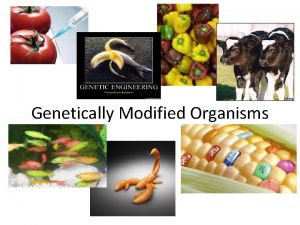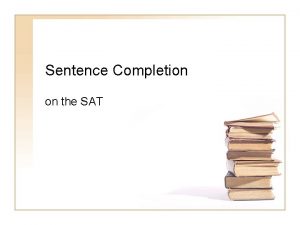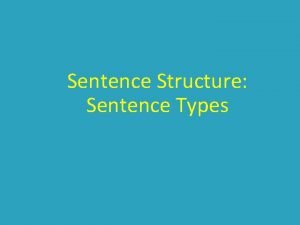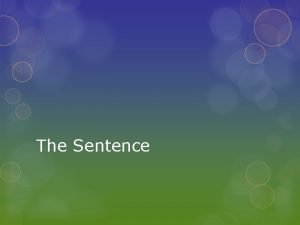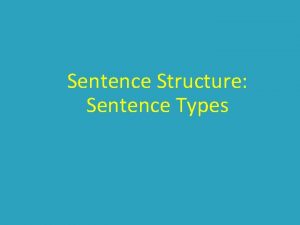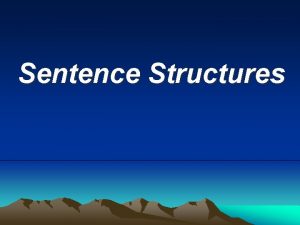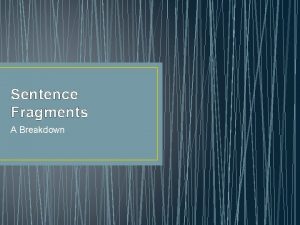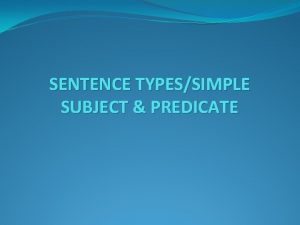The Modified Sentence Completion Task as a Scaffold

























- Slides: 25

The Modified Sentence Completion Task as a Scaffold for Expository Reading and Writing by José Montelongo, Ph. D. California Polytechnic State University

The Problem l Elementary students do not have an awareness of expository or informational text structures l Elementary students possess an awareness of the text structure for narrative stories – – – Parents read narrative stories to their children Most of the books students read in elementary school possessive narrative structures Most students in elementary reading programs such as Accelerated Reader select fictional books to read (Clifford books, R. L. Stine books)

The Problem Exacerbated l l Expository text is largely ignored in the early primary grades, where emphasis is on narrative text Strategies for reading expository text are not taught or developed in the upper elementary grades because teachers believe students already know how to read (Clinton, 2002)

Importance of Knowing Text Structure l Reflect logical connections among the ideas in text – – – Important for understanding and studying information contained in textbooks, reference books and nonfictional works Important for organizing information in memory Important for retrieving information

Some Ways of Organizing Information (i. e. , Types of Expository Structures) l l l Sequence (Chronological ordering of events) Comparison/contrast (Similarities & differences between things) Cause/effect (Reasons why something happens or exists) Problem-Solution (Statement of problem with steps for its solution) Generalization (Stating a main idea and defending it with supporting details)

Practical Importance of Knowing Informational Text Structures l l Students must be able to read textbooks if they are to be successful in the “Information Age” (Moss, Leone, & Dipillo (1997) In order to get information from the Internet students must be able to read expository text (Schmar-Dobler, 2003) l In an era of “high stakes testing, ” 70%-80% of reading content on standardized tests is expository. (Daniels, 2002)

Effects of Underconcern for Expository Reading l Students have problems organizing and remembering information resulting in lower-level and often faulty thinking l Students have problems identifying important information Students have problems finding the main ideas Students have problems remembering the information Students read a history book in the same way they would read a funny story l l l

Sentence Completion Task (Fill-in-the-Blanks Activity) l Students complete the sentences by filling in the blank with appropriate vocabulary word. – – Used nearly every time new vocabulary is introduced Used to reinforce vocabulary usage Used in every grade, K-12 and beyond Used in the language arts and content areas

Modified Sentence Completion Task (A better mousetrap? ) l l l Eight or more sentences requiring a vocabulary word to complete a sentence. A paragraph is embedded amongst the unrelated sentences. Students must fill in the blanks and abstract the related sentences. Students arrange the related sentences in order to form a paragraph and paste them onto a graphic organizer. Students use the abstracted paragraph as a scaffold for their own composition. (Montelongo, 2004; Montelongo & Hernández, forthcoming)

The Modified Sentence Completion Task and the Reading Classroom l l l Reinforce Vocabulary Usage Acquaint students with the different expository structures found in content area textbooks Reinforce Reading Skills such as Locating the Main Idea and Noting Important Supporting Details Reinforces Recognizing Signal Words Strengthens Use of different Graphic Organizers

The Modified Sentence Completion Task and the Content Area Classroom l l l Reinforce Content Area Vocabulary Reinforce Learning of Main Ideas in the Social Studies classrooms Acquaint students with the Text Structures particular to a specific discipline Aids students in writing expository paragraphs Representations of Arithmetic Word Problems Writing Science Laboratory Experiments

Advantages of the Modified Sentence Completion Task l l l Reinforces Expository Reading and Writing Skills throughout the Curriculum. Reinforces Expository Reading and Writing Skills throughout the School Year May be used to reinforce Content Area main ideas particular to unit of study and/or to reintroduce and review main ideas from prior learning.

More Significant Advantages of the Modified Sentence Completion Task l Challenges students to form mental representations of the information and to think logically: l l l While they search for the related sentences As they order their sentences to form a paragraph To include or delete supporting details as they write their own paragraphs When they create their own arithmetic word problems As they write their science laboratory reports

Grounding for the Modified Sentence Completion Task l Researchers suggest that reading skills instruction is much more fruitful when skills are taught in tandem rather than in isolation (Donndelinger, 2005).

Building Automaticity l Emphasizing links (such as connecting reading with writing processes) and providing enough practice opportunities to build automaticity are among the important metaprinciples for developing curricular components (Carver, 2001)

Practical Considerations

Advantages Creating Your Own Materials l l l Difficult to find materials that conform to one type of expository structure Teachers can create their own models Teachers can tailor the exercises for their own classes l l l Choose the content to be reinforced Modify vocabulary words Choose the different types of expository structures

Creating the Materials l l l Find paragraph(s) that contains a main idea from the unit currently being taught or from a previously learned unit Select a vocabulary word from each one of the sentences. If you can’t find a suitable word, use a challenging synonym of one of the words. Create challenging unrelated sentences (foils) Scramble the order of the related sentences Mix the related and unrelated sentences

Introducing the Modified Sentence Completion Task l l l l Introduce task using small groups Review vocabulary words Have students complete the fill-in-the-blanks exercises Ask students to cut out sentences and sort them into two piles: related and unrelated Have students arrange the sentences in logical order Have students paste the related sentences onto a graphic organizer Have students rewrite the paragraph in their own words

Maintenance of Modified Sentence Completion Task l l l Use to reinforce important content area concepts or main ideas Use when new vocabulary is introduced Use in different content areas: History, Science, Mathematics Assign tasks for homework Create more challenging activities: l l embed two paragraphs make categorization task more difficult

Technology and the Modified Sentence Completion Task http: //www. angelfire. com/ill/monte/textstructure. html

Advantages of Posting Activity on the Web l l l Students can work more creatively on a computer Permits students to self-correct their work Allows students to type their compositions Students may avail themselves of reference works such as on-line encyclopedias, thesauri, dictionaries, and the Internet. Students can embellish their own work by using clip art or pictures from the Internet (Montelongo, Herter, and Littlefield-Cortez, in preparation)

For Which Students? l Basically, this exercise can probably be done by any student that can complete a fill-in-theblanks activity – l l Williams (2004) suggests that students in the second grade are sensitive to text structure Students at the fourth grade and above like it Great with adult ESL students

Use in Math/Science Classes l Use for word problems as a diagnostic tool What information are students using to solve word problems? (Montelongo, Riley, Berber-Jiménez, and Herter, in preparation) l Use in Science Classes Structure laboratory reports (Montelongo, Berber-Jiménez, Hernández, and Hosking, 2006; Berber-Jiménez, Montelongo, Hernández, and Hosking, submitted)

References l l l l l Clinton, P. (2002). Literacy in America: The crisis you don’t know about. Book, 1 -7, http: //www. bookmagazine. com/issue 24/literacy. shtml. Daniels, H. (2002). Expository text in literature circles. Voices From the Middle, 9, 7 -14. Donndelinger, S. J. (2005). Integrating comprehension and metacognitive reading strategies. In S. E. Israel, C. C. Block, K. L. Bauserman, and K. Kinnucan-Welsch (eds. ), Metacognition in literacy learning: Theory, assessment, instruction, and professional development. Mahwah, NJ: Lawrence Earlbaum Associates, 241 -260. Garner, R. , Alexander, P. , Slater, W. , Hare, V. C. , Smith, T. & Reis, R. (1986). Children’s knowledge of structural properties of expository text. Journal of Educational Psychology, 78, 411 -416. Montelongo, J. A. (2004). Reinforcing student’s knowledge of expository paragraph structure through sentence completion exercises. New Mexico Journal of Reading, 24, 14 -22. Montelongo, J. A. , Berber-Jiménez, L, Hernández, A. C. , & Hosking, D. (2006). A vocabulary activity to reinforce text structure fluency in a science class. Science Teacher, 73(2), 28 -31. Montelongo, J. A. and Hernández, A. C. (forthcoming). Reinforcing expository reading and writing skills: A more versatile sentence completion task. The Reading Teacher. Moss, B. , Leone, S. & Dipillo, M. L. (1997). Exploring the literature of fact: Linking reading and writing through information trade books. Language Arts, 74, 418 -429. Schmar-Dobler, E. (2003). Reading on the Internet: The link between literacy and technology. Journal of Adolescent & Adult Literacy, 47, 80 -85. Wood, K. D. , Lapp, D. , & Flood, J. (1992). Guiding readers through text: A review of study guides. Newark, DE: International Reading Association
 Sentence completion activity
Sentence completion activity Discourse completion task
Discourse completion task Task completion email sample
Task completion email sample Completion test
Completion test Intensive speaking activities
Intensive speaking activities Lesson 7 sentence completion
Lesson 7 sentence completion Sentence completion activity
Sentence completion activity Children's thematic apperception test
Children's thematic apperception test Tiered task bias task
Tiered task bias task Irrelevant sentence
Irrelevant sentence Complete the incomplete sentences
Complete the incomplete sentences Fascia and gutter scaffold
Fascia and gutter scaffold Tank builders scaffold
Tank builders scaffold Each platform must be fully planked
Each platform must be fully planked Why does dimmesdale go to the scaffold
Why does dimmesdale go to the scaffold Trestle scaffolding diagram
Trestle scaffolding diagram Mobile scaffold accident
Mobile scaffold accident Tg 20:13
Tg 20:13 Dead shores
Dead shores Drupal composer project
Drupal composer project Scaffold and fade-away technique
Scaffold and fade-away technique Writing a business report structure & examples
Writing a business report structure & examples Cariotipo del maiz
Cariotipo del maiz Feature article scaffold
Feature article scaffold Petal paragraph scaffold
Petal paragraph scaffold Txxxc writing model
Txxxc writing model
